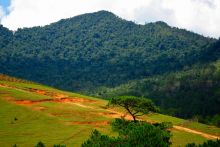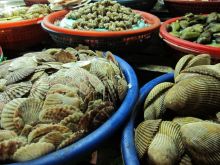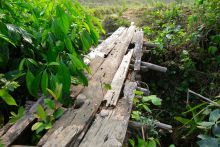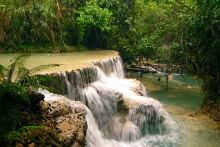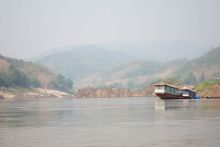My first reaction after crossing the border with Laos was – oh my god, it is so green. Laos is abundant with nature, but there is something about Vietnam that makes its different. Blue skies and extreme greenery as far as an eye can see. It all is really beautiful. Rapid industrialization takes its toll though. As everywhere in Asia (minus Singapore) non-biodegradable garbage is all over the place and deforestation is rampant. Deforestation is not evident though, as in Laos, where you see scars left by the slash & burn practice everywhere. In fact I would not know anything about deforestation, unless I was told about it. Hills in Da Lat are covered with fields and plantations, while only several years ago they used to host forests. It even looks pretty with green tidy fields, unless I was not aware of the past. Ignorance is truly bliss sometimes. On the other hand all those strawberries have to come from somewhere.
I entered the country in the central Vietnam right in the hear of DMZ, where most of the fighting took place. Today the area is abundant with graveyards. I saw quite a few on my way to Hue, which made me think about the futility of war. Ten years of fighting, millions dead, devastated industry and infrastructure and all for nothing. United States and other aggressors never paid any war reparations or made any formal apologies. Agent Orange victims have tried to sue manufacturers of Agent Orange for years, but all in vain. How the hell you can attack a country like this and then just pretend the whole thing never happened? Simply mind-blowing. What is even more mind-boggling is that the history is repeating itself today in Afghanistan and Iraq. And it is business as usual: both wars are still going on with no attention is being paid to any of them any more, people are getting killed and the war economic machine is going full speed ahead. Anyhow, back to Vietnam. A good thing is that American and other wars are things of the past, even though the aftermath still rears its ugly head, like all the Agent Orange victims. Vietnamese in general and especially younger generation do not seem to hold the grudge against USA or France. US dollars are widely accepted as a currency and you see US branded clothing and accessories everywhere. It works in the other direction too. I have talked with several old American war veterans, who fell in love with the modern in Vietnam and made it their home. It is all water under the bridge. Indeed why cling to the past, when you can live in the present moment?
One of Vietnam’s highlights for me was food, which is just yummy and totally different to anything I have tasted before. Fresh spring rolls, friend wontons, pha, fried frogs, all kind of seafood and myriad of other things I have no name for. The cuisine can be best described as some sort of a fusion of Chinese and Thai cuisine, but in reality is totally unique and just awesome. Herbs as mint, basil and local varieties I have knowledge about are a big part of the cuisine. A nice touch is a complimentary bowl of herbs you get along with your food. Either you chew them as a healthy snack or add to your meal is your choice. My best food experiences were when I was out eating with locals, who knew magic words that brought all those secret delicacies to the table. English menu was often limited to rice and noodles with a couple of add-ons. It was especially frustrating, when I saw locals over a next table having a proper feast on the things I did not see on the menu. Food is very cheap too, even by South East Asian standards. I would love to visit Vietnam anytime just for the food experience.
In a nutshell, Vietnam is awesome. With a rapid economic growth and extremely determined people, I think they are destined for a great future. Next Asian Tiger or even the next mini-China maybe? Time will tell for sure. For now it is a lovely country with rich culture, delicious food, friendly people and low prices. Love it.
